|
Melbourne
Australia's grand lady
By
Richard Moore
Images
of Melbourne's Yarra River
Images
of Yarra River at Night
Photos
of Melbourne's architecture
A trip to the capital city of Victoria will soon show you why it
is known as Marvellous Melbourne.
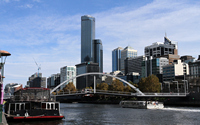 The
city is built by Port Phillip Bay and is Australia's cultural beacon
with a thriving arts community highlighted in wonderful
public galleries, as well as museums and superb
restaurants. The
city is built by Port Phillip Bay and is Australia's cultural beacon
with a thriving arts community highlighted in wonderful
public galleries, as well as museums and superb
restaurants.
Melbourne
is home to more than 4 million people and it is regularly chosen
as the World's Most Liveable City.
It
is modern with some stunning new architecture
but, fortunately, its planners have kept the marvellous old buildings
from its rich history.
One
of the most grand buildings is Victoria's
State Parliament in Spring St. If you are into architecture
you should also visit the State
Library of Victoria in Swanston St, the Royal
Exhibition Building (near the Melbourne
Museum) in the Carlton Gardens or a host of others
listed
here.
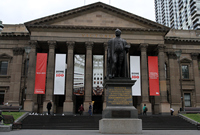 Melbourne's
Central Business District is built in a grid with a fairly easy
to follow layout. Once you work out the main streets, like Bourke
St, and their corresponding siblings, such as Little Bourke St,
it makes for quick orientation. Download
a map from here. Melbourne's
Central Business District is built in a grid with a fairly easy
to follow layout. Once you work out the main streets, like Bourke
St, and their corresponding siblings, such as Little Bourke St,
it makes for quick orientation. Download
a map from here.
Food is almost an obsession with Melburnians and the list of places
to eat out is breathtakingly long and varied.
Fine
dine at upmarket establishments, or pop into a low-key ethnic restaurants
serving up all manner of delightful cuisines. Here
are some of the places where you will find great eateries.
For
some marvellous fresh produce you could pop in to the Queen
Victoria Market to the north end of the CBD.
You
can buy your normal market goods but the exciting places to wander
through are the food halls, which offer fabulous fish, deli goods,
cheeses, breads, meats and seafood.
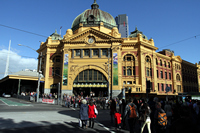 Inner
Melbourne is really easy to get around. The city has an excellent
public
transport system that mainly uses trams - in the
central and more established areas - and trains that branch out
from the CBD to the outer metropolitan areas. Buses then link between
the rail lines. Inner
Melbourne is really easy to get around. The city has an excellent
public
transport system that mainly uses trams - in the
central and more established areas - and trains that branch out
from the CBD to the outer metropolitan areas. Buses then link between
the rail lines.
The
main train station in the CBD is Flinders St - a majestic old complex
fronted by its famed clocks. When a Melburnian says "I'll meet
you under the clocks" it means the steps in front of Flinders
St.
There
are a number of other central stations that make up the underground
City Loop and all will get you anywhere on the Metro train system.
A daily full-fare pass will cost about $7.
The
former Spencer St Station at the western end of the CBD has had
a massive makeover and is now known as Southern Cross Station. It
has stores galore, including factory outlets.
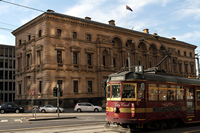 For
those of you who fancy taking a ride on a vintage tram - and it
is a fun way to travel - there is a free City Circle service running
around the CBD. For
those of you who fancy taking a ride on a vintage tram - and it
is a fun way to travel - there is a free City Circle service running
around the CBD.
The
bayside suburb of St
Kilda is well worth a visit - with a long pier,
excellent eateries and Luna Park fun ground.
On
the way you can stop off at the Shrine
of Remembrance built in honour of Australia's war dead. The
exterior and grounds are beautiful, with magnificent carvings adorning
the Shrine and a towering monument to sailors next to the Eternal
Flame.
Melburnians
are a sports-mad lot and even a game
of tiddlywinks is likely to attract a crowd.
The
city hosts the Australian Open tennis in January, the Melbourne
Formula One GP at Albert Park, cricket matches, rugby league, union
and soccer games. The pride of Victorian sport however is Australian
Rules Football a highly skilled all action contest between club
sides in front of up to 80,000 people at the Melbourne Cricket Ground.
An
Aussie Rules game is a must see when
you are in Melbourne - it is a true experience.
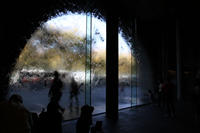 So
is visiting the National Gallery of
Victoria. So
is visiting the National Gallery of
Victoria.
The
NGV has two wonderful galleries within in a short walk of each other.
There is the Ian Potter Centre, which houses Australian and Aboriginal
art in Federation Square, and the Arts Centre home to more than
70,000 pieces of art from around the globe. It is regarded as being
one of the most impressive collections in the Southern Hemisphere.
Also
in Federation Square is the Australian Centre for the Moving Image.
Entry
is free to all of the three above galleries.
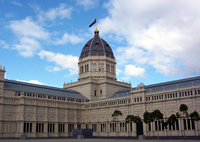 Melbourne
is home to a large number of museums covering many distinct parts
of its history. They include Melbourne
Museum, which showcases Australia's social history, indigenous
peoples, science and the environment, the National Sports Museum,
the Hellenic Museum, the Chinese Museum, Immigrants Museum, the
Jewish Museum of Australia and the Jewish Holocaust Centre. Melbourne
is home to a large number of museums covering many distinct parts
of its history. They include Melbourne
Museum, which showcases Australia's social history, indigenous
peoples, science and the environment, the National Sports Museum,
the Hellenic Museum, the Chinese Museum, Immigrants Museum, the
Jewish Museum of Australia and the Jewish Holocaust Centre.
And
for families there are plenty of things to do that the kids will
love.
Visit
the Melbourne Aquarium
in Flinders St, check out the views over the city at Eureka
Skydeck 88, Melbourne has a terrific zoo in Carlton and there
is the fabulous Scienceworks Museum in Spotswood.
Whatever
you want to do can be done in Melbourne - it is marvellous.
Oh,
and did we mention the shopping ...
Melbourne
Interactive Map
|
